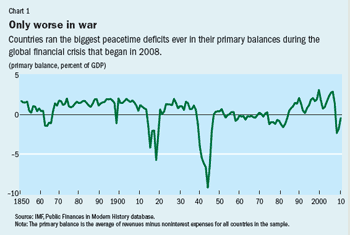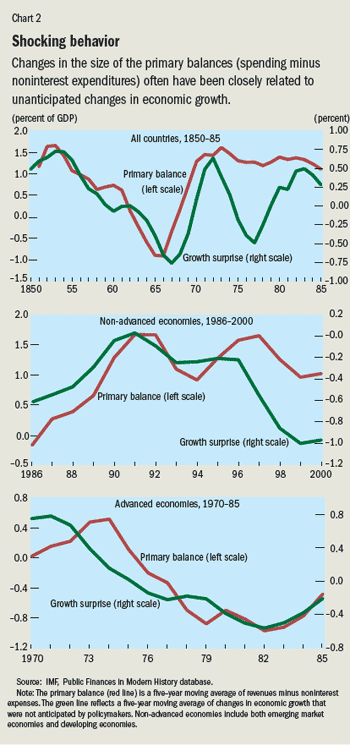Prudent or Profligate
Finance & Development, June 2013, Vol. 50, No. 2
Paolo Mauro, Rafael Romeu, Ariel Binder, and Asad Zaman
A new database permits a two-century look at countries’ success in managing their debt

Whether governments are taking sufficient measures to ensure the sustainability of public debt has become an important public policy question as sovereign debt has risen to unprecedented peacetime levels. Political realities and weak economic growth often call for delayed expenditure cuts or tax increases, but a high or potentially rising interest burden would argue for the opposite—fiscal adjustment—by raising revenues, trimming spending, or both.
Are countries doing enough to reduce their deficits in response to increases in their debt-to-GDP ratios? Are fiscal (tax and spending) policies sufficiently prudent, or are countries behaving in a profligate manner? And how can fiscal “prudence” or “profligacy” be assessed empirically? Answers to these questions cannot be based on data for only one or even a few years. Rather, they require a longer-term perspective and call for delving into some fascinating economic history.
Economists have increasingly drawn on historical data to analyze fiscal issues. For example, in This Time Is Different, Harvard professors Carmen M. Reinhart (see People in Economics in this issue of F&D) and Kenneth S. Rogoff look back at eight centuries of public debt and fiscal crises. In a recent study we examined 55 countries’ fiscal policy decisions during 1800–2011 (Mauro and others, 2013), using the most comprehensive cross-country data set assembled to date (see box).
The history of public finances

The IMF's new database, Public Finances in Modern History (IMF), documents 200 years of budget deficits and government debt. The data cover 55 countries—24 of them considered advanced economies. Half of the observations are drawn from historical publications that cover many countries; the other half were collected from country-specific sources such as government publications or economic histories that include public finance statistics. The data set consists of both fiscal stocks (such as the level of government debt at a particular moment) and flows (such as spending and revenue collection), which makes it possible to document the primary balance of governments far back in history.
The data begin in the early 1800s for a handful of countries (for example, Sweden, United Kingdom, United States), and the coverage gradually increases—to more than 20 countries by 1880 (a geographically diverse group that includes Argentina, India, and Japan). By the 1920s the coverage reaches about 30 countries (including several "emerging markets").
Chart 1 illustrates the breadth of the data set. It presents the GDP-weighted average of the historical primary balance for the countries in the sample over the past century and a half. It is apparent, for example, that the worsening in the primary balance experienced during the global economic and financial crisis that began in 2008 is exceeded only by that associated with the two world wars.
We found, for example, that the authorities often mistake a persistent decline in economic growth for a temporary slowdown and, because of this misperception, respond inappropriately. We also found that when governments face high borrowing costs they tend to become more prudent. And the data show that the global economic and financial crisis that began in 2008 resulted in the largest peacetime government deficits in history.
Enabling better analysis
The availability of data not only on fiscal stocks (say, the amount of debt at any given time) but also on fiscal flows (deficits, which change the stock of debt) and, crucially, on their subcomponents (revenues, noninterest expenditures, and the interest bill) makes it possible to apply modern tests of fiscal sustainability. These typically focus on the primary fiscal balance (the difference between a government’s revenues and its noninterest expenditures), which is the most accurate reflection of fiscal policy decisions within government control.
Longer data series and a wider array of countries make additional econometric methods feasible. The study gauges the degree of fiscal prudence or profligacy for each country over the course of its history. It also identifies the factors underlying changes in the degree of fiscal prudence or profligacy.
Drawing on historical series of fiscal data, it is possible to study the evolution of fiscal prudence and fiscal profligacy—terms often used, somewhat loosely, to denote whether government budget policies are sustainable or unsustainable. Sustainability is judged by whether the expected value of all future budget surpluses is sufficient to pay off the public debt (whether the intertemporal budget constraint is met). In practice, prudence and profligacy are medium-term concepts. Neither is built up overnight: one or even a few years of budget deficits do not necessarily cause a fiscal crisis, given a strong initial position. Still, a few years of persistent deficits could well suggest the need for a correction to avoid passing on an unbearable debt to future generations. Thus, judgments regarding whether prudence or profligacy prevails are necessarily made over several years. Moreover, a country’s degree of prudence is not constant. It will change over time, as governments, citizens’ attitudes, and economic circumstances (such as interest rates and long-run economic growth) change.
Tests of fiscal policy sustainability ask whether projected policies are adequate to stabilize the debt-to-GDP ratio. In academia, a test of fiscal policy sustainability developed by Henning Bohn (1998) has gained popularity. It measures the extent to which policymakers respond to increases in debt with decisions that lead to an improved primary balance. When this response is positive and statistically significant, the country’s fiscal policy is judged sustainable.
One challenge of using these tests is that they require many years of country-specific historical data. Because of this limitation, earlier research has focused on a few countries with easily available long-term data. Now, thanks to the availability of data that go back a long time, we can identify periods of prudence and profligacy for each of the 55 countries in the sample. Our use of the terms “prudence” and “profligacy” is technical, not judgmental. For example, a fiscal stimulus that leads the primary balance to deteriorate at a time when the debt-to-GDP ratio is rising (profligate behavior) may well be justified as an effort to avoid a deep and prolonged recession.
Our analysis uncovers some important economic factors that drive changes in prudent behavior. Such factors include unexpected changes in long-term economic growth and changes in real interest rates. The evidence suggests that countries tend to become more profligate when their long-term real GDP growth is lower than anticipated. That is, when long-term growth (assessed by researchers in hindsight) declined compared with policymakers’ expectations based on data available to them at the time, those policymakers were likely to perceive the GDP slowdown as temporary and tended to respond with fiscal loosening (lower taxes, increased spending, or both). In such cases, the outcome is often fiscal profligacy. In addition, higher real interest rates (long-term government rates adjusted for inflation) are found to increase prudence. As one might expect, when real borrowing costs increase, governments save more and borrow less.
Historical periods
The historical periods covered in these data can be broadly divided into the mid-19th century (1850–80), the first period of globalization (1880–1913), the period between the world wars (1919–39), the postwar period (1950–2007), and the global financial crisis (2008–11).

The effect on fiscal prudence of long-term growth shocks can be seen both in the mid-19th century period and, more recently, in the 1970–2000 period. Chart 2 tracks the average primary balance (red line) against the average growth surprise (green line). A negative growth surprise (that is, when the green line is below zero) indicates that actual long-term growth turned out lower than policymakers would have anticipated based on the data available to them in real time. This is not the result of lower cyclical growth on so-called automatic stabilizers, such as revenues that fall when the economy slows, and cyclically sensitive expenditures such as unemployment benefits. Rather, it is the result of policymakers erroneously perceiving a long-term downturn in growth as a cyclical slowdown and responding to it with fiscal loosening or insufficient tightening.
In the 1860s and mid-1870s (see Chart 2, top panel), negative growth surprises coincided with civil or unification wars (for example, in the United States and Italy), strong emigration from parts of Europe (for example, Sweden), and financial panics. The financial crisis of 1873 led to a prolonged recession that was at the time considered the most difficult economic period ever. The deficit in average primary balances tracked these growth surprises closely.
Similarly, in the 1970s (see Chart 2, bottom panel), negative growth surprises from the sudden rise in oil prices turned out to be associated with a deterioration in primary balances. This effect is most apparent in Japan, where economic growth slowed significantly in the mid-1970s, after a period of rapid economic growth. Policymakers there seem to have based their fiscal policy decisions on optimistic forecasts of long-run economic growth, and a belief that the unexpected growth slowdown was temporary. That misperception may have led to fiscal decisions that, in hindsight, look profligate—resulting in rising debt and primary deficits in the late 1970s and early 1980s. A similar sequence of events occurred in Japan in the late 1990s with the bursting of what in hindsight was an asset price bubble.
In emerging markets, sizable adverse shocks to long-run growth occurred in the late 1980s and, especially, the late 1990s, and during both periods those countries’ primary fiscal balances worsened considerably (see Chart 2, middle panel).
High borrowing costs and growth slowdowns
Greater fiscal prudence as a result of higher interest rates is evident in Chart 3. During the first period of globalization from 1880 to 1913 (top panel), sizable primary surpluses at first coincided with high real long-term interest rates. Lower rates after 1900 were associated with a reduction in the average primary fiscal balance. During 1970–90 (bottom panel), the increase in long-term real interest rates associated with the severe monetary tightening in the United States was followed by an improvement in the primary balances.

Consistent with the impact of worldwide developments on long-term growth surprises and interest rates, some periods in history are characterized by large numbers of relatively prudent or profligate countries. Chart 4 provides a broad overview of the post–World War II period, showing the number of fiscally profligate advanced economies each year alongside their weighted average government debt and primary balance (in percent of GDP). During the 1950s and 1960s, advanced economies lowered their debt levels by maintaining moderate primary surpluses (and benefiting from rapid economic growth and moderate interest rates). The degree of prudence improved as the effects of World War II faded. The decline in long-term growth triggered by the oil shocks of the 1970s then reduced the number of prudent countries and increased the number of profligate countries. During the 1980s and 1990s, fiscal adjustment efforts—prompted in part by higher global interest rates—were associated with stronger primary balances and an increase in the number of countries found to be prudent.

The global financial and economic crisis that started in 2008 brought about the largest and most pervasive peacetime deterioration of fiscal balances in history. The number of prudent countries declined sharply. Indeed, the data suggest that for countries found to be generally fiscally prudent until the onset of the Great Recession (including the United States and Spain), the fiscal response to the crisis—which included more government spending and lower tax receipts—tipped the balance to profligacy (during 2009–11 for the United States and in 2010 for Spain). For others—such as France and Japan—that were profligate before 2008, the response to the crisis worsened their primary balances while debt grew.
The new database also demonstrates that behavior changes. A given country is not forever prudent or profligate. Just as countries change—as a result of political, social, institutional, or economic developments—so does their degree of fiscal prudence or profligacy. This simple observation implies that policymakers and the public at large should not take a long-established tradition of fiscal prudence for granted; conversely, countries are not doomed to remain fiscally profligate if they take appropriate corrective measures.
The lesson countries can take away from these findings is clear: the policy decisions they make in the near future will have a lasting effect on their long-term fiscal posture. Most advanced economies face major fiscal challenges. High borrowing costs have already prompted some to undertake major fiscal adjustment. Others are adjusting more slowly to support a tentative recovery while trying to preserve market confidence in their long-term commitment to fiscal prudence. Whether these countries are judged prudent or profligate a few years from now will depend on fiscal policy decisions as well as on the extent to which long-lasting economic growth resumes. ■
Paolo Mauro is an Assistant Director in the IMF’s African Department. Rafael Romeu is a Senior Economist, and Ariel Binder and Asad Zaman are Research Analysts, all in the IMF’s Fiscal Affairs Department.
References
Bohn, Henning, 1998, “The Behavior of US Public Debt and Deficits,” Quarterly Journal of Economics, Vol. 113, No. 3, pp. 949–63.
International Monetary Fund, Public Finances in Modern History database, www.imf.org/external/np/FAD/histdb
Mauro, Paolo, Rafael Romeu, Ariel Binder, and Asad Zaman, 2013, “A Modern History of Fiscal Prudence and Profligacy,” IMF Working Paper 13/5 (Washington: International Monetary Fund).
Reinhart, Carmen M., and Kenneth S. Rogoff, 2009, This Time Is Different: Eight Centuries of Financial Folly (Princeton, New Jersey: Princeton University Press).


